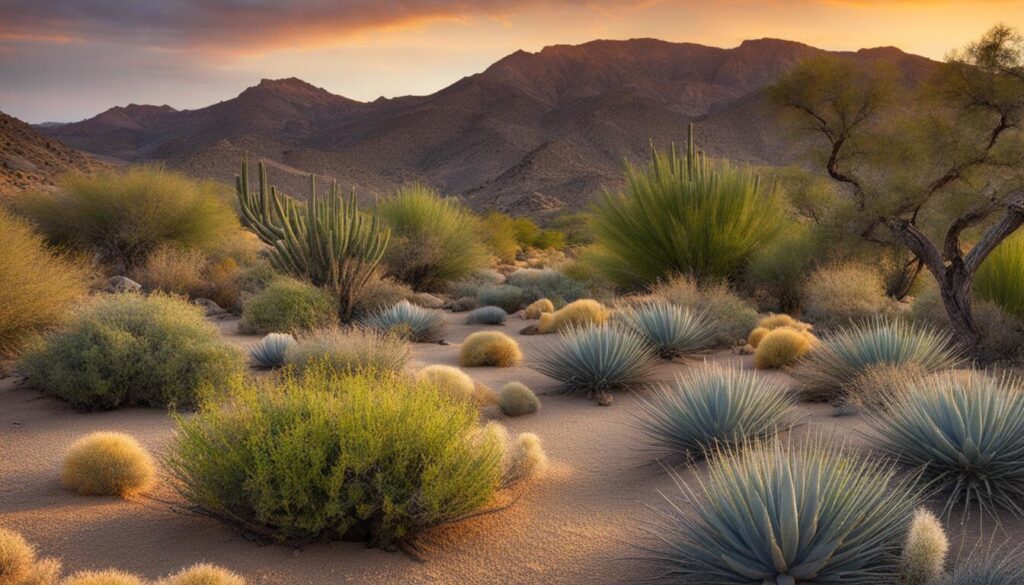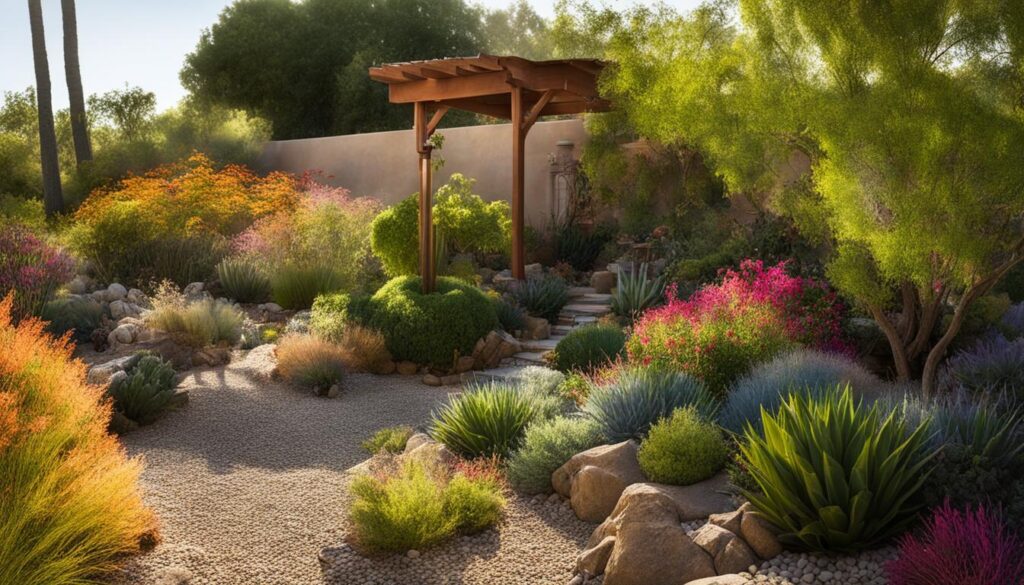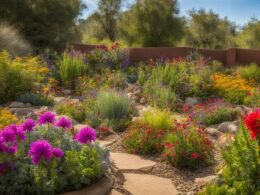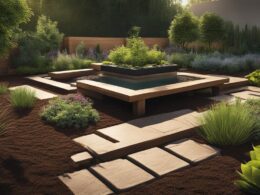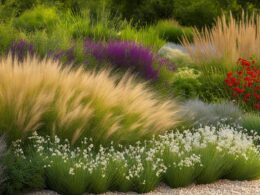Are you considering a xeriscaping project for your yard? Choosing the right shrubs is crucial for creating a beautiful and water-efficient landscape. Xeriscaping is a landscaping technique that focuses on minimizing water consumption, making it ideal for regions with limited rainfall. Whether you live in a dry environment or simply want to reduce your water usage, xeriscaping can offer numerous benefits.
Key Takeaways:
- Xeriscaping is a landscaping technique that aims to minimize water consumption.
- It can be implemented anywhere, not just in dry environments.
- Xeriscaping offers benefits such as water conservation, reduced maintenance, and a positive impact on the environment.
- Choosing region-appropriate plants native to the local environment is recommended for a successful xeriscaping project.
- Irrigation and ongoing maintenance are essential for the health and longevity of xeric plants.
Understanding the Difference Between Drought-Resistant and Drought-Tolerant Plants
When embarking on a xeriscaping project, it’s essential to grasp the distinction between drought-resistant and drought-tolerant plants. Drought-resistant plants, like cacti and succulents, are well-adapted to thrive in arid conditions, as they can survive in a perpetual state of drought and require minimal maintenance. These plants have evolved specific features, such as fleshy leaves or shallow root systems, to store water efficiently.
On the other hand, drought-tolerant plants can withstand periods of drought but may require occasional watering to survive prolonged dry spells. They are more flexible in terms of water needs and have the ability to adapt to varying moisture levels. Native grasses, lavender, and rosemary are examples of drought-tolerant plants that can add texture and color to your xeriscaped garden.
When deciding between drought-resistant and drought-tolerant plants for your xeriscaping project, consider the climate and ecological factors specific to your region. If you live in an area with extremely limited rainfall and want to minimize maintenance, drought-resistant plants may be the ideal choice. However, if you have the capacity to provide occasional watering during dry spells and want a wider variety of plant options, incorporating drought-tolerant plants can offer a more diverse and visually appealing landscape.
Benefits of Drought-Resistant and Drought-Tolerant Plants:
- Drought-resistant plants require minimal maintenance and can survive in arid conditions.
- Drought-tolerant plants offer more flexibility and can adapt to varying moisture levels.
- Integrating both types of plants creates a visually appealing and diverse xeriscaped garden.
- They contribute to water conservation efforts by reducing overall water consumption.
- These plants are well-suited for regions with limited rainfall and hot summers.
“Understanding the distinction between drought-resistant and drought-tolerant plants empowers you to make informed decisions when selecting the best plants for your xeriscaping project.”
By choosing the right combination of drought-resistant and drought-tolerant plants, you can create a stunning xeriscape that not only conserves water but also adds beauty and character to your outdoor space. So, whether you opt for the low-maintenance resilience of drought-resistant plants or the adaptability of drought-tolerant varieties, your xeriscaped garden will thrive, even in the face of water scarcity.
Tips for Planning a Xeriscaping Project
Planning is an essential step in creating a successful xeriscaping project for your yard. By following these tips, you can ensure that your project is well thought out and tailored to your specific needs and the local environment.
Create Water Zones
One of the key aspects of a xeriscaping project is dividing your yard into water zones. This helps optimize water usage and ensures that each area receives the appropriate amount of irrigation. The oasis zone, which is closest to your house, should include high-moisture plants and require more frequent watering. The transition zone requires less irrigation, and the xeric zone, furthest from your house, requires the least amount of watering. By strategically planning these zones, you can create a beautiful and water-efficient landscape.
Replacing Your Lawn
If you’re considering replacing your lawn as part of your xeriscaping project, there are several alternatives to consider. Mulch, rocks, and gravel can be used to create aesthetically pleasing areas that require minimal watering. You can also incorporate lawn islands in less frequently used areas for pets or children to enjoy. By eliminating or reducing the size of your traditional lawn, you can save water and reduce maintenance while still having a beautiful yard.
Choose Region-Appropriate Plants
When selecting plants for your xeriscaping project, it’s important to choose species that are native to your region. These plants are adapted to the local climate, soil conditions, and rainfall patterns, making them more likely to thrive and require less maintenance. Native plants also provide important habitat for local wildlife and contribute to the overall biodiversity of your yard. Research and consult with local experts to ensure that you choose the right plants for your xeriscaping project.
By following these tips, you can effectively plan your xeriscaping project and create a beautiful, water-wise landscape that enhances the value of your property and conserves precious resources.
Irrigation and Ongoing Maintenance in Xeriscaping Projects
Proper irrigation is crucial for the success of xeriscaping projects. While xeric plants are known for their ability to withstand drought, they still require some level of watering, especially during the establishment phase. Deep watering infrequently is key to encouraging the plants’ roots to grow deeper and improve their drought resistance. To achieve this, consider setting up a drip irrigation system that delivers water directly to the plants’ roots, minimizing water wastage. This method also helps conserve water by reducing evaporation.
When it comes to ongoing maintenance in xeriscaping projects, there are a few tasks to keep in mind. Regular pruning is necessary to maintain the health and shape of the plants. It’s important to remove any dead or diseased branches and to shape the plants as needed. Additionally, mulch replacement should be done periodically to help retain moisture in the soil, suppress weeds, and improve the overall appearance of the landscape. Adjusting the irrigation system based on seasonal changes and plant needs is essential to avoid overwatering or underwatering.
In some cases, plant replacement might be necessary. Despite their resilience, xeric plants can still be susceptible to diseases or damage caused by extreme weather conditions. Monitor the condition of your plants regularly and replace any that show signs of distress. Remember to choose plants that are well-suited to your region’s climate and soil conditions to increase their chances of thriving with minimal maintenance.
Key Points:
- Deep watering infrequently encourages the plants’ roots to grow deeper and improves their drought resistance.
- Consider installing a drip irrigation system to deliver water directly to the plants’ roots and minimize water wastage.
- Regular pruning, mulch replacement, and adjusting the irrigation system are important ongoing maintenance tasks in xeriscaping projects.
- Monitor the condition of the plants and replace any that show signs of distress.
- Choose region-appropriate plants to increase their chances of thriving with minimal maintenance.
“Proper irrigation and ongoing maintenance are vital aspects of xeriscaping projects. By implementing efficient watering techniques and staying on top of maintenance tasks, you can ensure the health and longevity of your xeric plants while conserving water.”
How Can I Choose the Right Native Shrubs for Xeriscaping?
When choosing native shrubs for ecofriendly xeriscaping, consider plants that are adapted to your region’s climate and soil. Look for species with low water requirements and a tolerance for drought. Native shrubs can provide beauty and biodiversity while reducing the need for irrigation in your xeriscape garden.
The Benefits of Xeriscaping: A Water-Friendly and Beautiful Landscape
Xeriscaping offers a wide range of benefits, making it an attractive option for homeowners. One of the main advantages is water conservation, with xeriscaping projects allowing homeowners to significantly reduce their water consumption and cut water bills in half. By incorporating drought-resistant and drought-tolerant plants, xeriscaping minimizes the need for excessive watering, making it a water-friendly gardening solution. This not only helps preserve precious water resources but also contributes to a more sustainable and environmentally responsible approach to landscaping.
Another benefit of xeriscaping is the creation of a unique and aesthetically pleasing landscape. By using region-appropriate native plants, homeowners can design a beautiful yard that complements the natural environment and requires minimal maintenance. Xeriscaping gardens are known for their visually appealing textures, colors, and shapes, creating a visually stunning and harmonious outdoor space. Furthermore, xeriscaping has been proven to increase property value. With more homebuyers seeking low-maintenance, eco-friendly yards, a well-designed xeriscaping project can significantly enhance the curb appeal and marketability of a property.
In addition to water conservation and visual appeal, xeriscaping contributes to a more sustainable and pesticide-free garden. By eliminating water-intensive lawns and incorporating native plants, xeriscaping reduces the need for harmful chemical fertilizers, pesticides, and excessive watering. This creates a healthier environment for both humans and wildlife, promoting biodiversity and attracting beneficial pollinators like butterflies and bees. Xeriscaping gardens become thriving ecosystems that support local wildlife and create a natural habitat for various species.
Moreover, xeriscaping can also lead to financial incentives from local governments. Many cities and municipalities offer programs like “cash for grass” rebates, where homeowners receive financial rewards for replacing water-dependent lawns with xeriscaped gardens. These incentives help offset the initial costs of xeriscaping projects and further encourage homeowners to embrace water-friendly gardening practices.
Key Benefits of Xeriscaping:
- Significant water conservation
- Reduced water bills
- Creation of a unique and visually appealing landscape
- Increased property value
- A more sustainable and pesticide-free garden
- Financial incentives from local governments
“Xeriscaping allows homeowners to design beautiful and water-efficient landscapes while also contributing to water conservation efforts and creating a sustainable environment.” – [Your Name], Landscaping Expert
Conclusion
In conclusion, xeriscaping is an effective and environmentally friendly landscaping technique suitable for regions with limited rainfall. By implementing xeriscaping projects, homeowners can enjoy numerous benefits, including water conservation, reduced maintenance, increased property value, and even financial incentives from local governments.
By carefully choosing drought-resistant and drought-tolerant plants, homeowners can create a beautiful and water-efficient landscape that requires less water and maintenance compared to traditional lawns. The strategic planning of the xeriscaping project, dividing the yard into different water zones, and replacing the lawn with alternative materials such as mulch, rocks, or gravel, all contribute to creating an aesthetically pleasing and sustainable outdoor space.
Efficient irrigation systems, such as drip irrigation, help to provide deep watering and conserve water, while ongoing maintenance tasks, including pruning, mulch replacement, and adjusting irrigation systems, ensure the health and longevity of the plants in the xeriscaped garden. Xeriscaping not only saves money on water bills but also promotes a more sustainable and responsible approach to landscaping, contributing to a pesticide-free garden and attracting wildlife.
Incorporating xeriscaping techniques not only enhances the beauty of your landscape but also demonstrates your commitment to water conservation and environmental stewardship. Whether you reside in a region prone to drought or simply want to create a low-maintenance and water-friendly yard, xeriscaping is an excellent choice that benefits both you and the environment.






